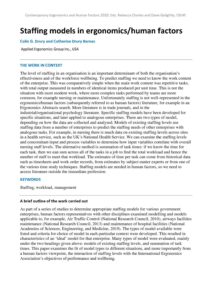| Document | Author Colin G. Drury and Catherine Drury Barnes |
| Abstract The level of staffing in an organisation is an important determinant of both the organisation’s effectiveness and of the workforce wellbeing. To predict staffing we need to know the work content of the enterprise. This was comparatively simple when the main work content was repetitive tasks, with total output measured in numbers of identical items produced per unit time. This is not the situation with most modern work, where more complex tasks performed by teams are more common, for example nursing or maintenance. Unfortunately staffing is not well-represented in the ergonomics/human factors (subsequently referred to as human factors) literature, for example in an Ergonomics Abstracts search. More literature is in trade journals, and in the industrial/organisational psychology literature. Specific staffing models have been developed for specific situations, and later applied to analogous enterprises. There are two types of model, depending on how the data are collected and analysed. Models of existing staffing levels use staffing data from a number of enterprises to predict the staffing needs of other enterprises with analogous tasks. For example, in nursing there is much data on existing staffing levels across sites in a health service, such as the UK’s National Health Service. We can examine the staffing levels and concomitant input and process variables to determine how input variables correlate with overall nursing staff levels. The alternative method is summation of task times: if we know the time for each task, then we can sum across all of the tasks in a job to find the total workload and hence the number of staff to meet that workload. The estimates of time per task can come from historical data such as timesheets and work order records, from estimates by subject matter experts or from one of the various time study techniques. Staffing models are needed in human factors, so we need to access literature outside the immediate profession. |

